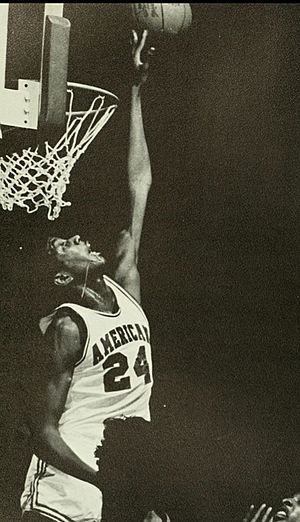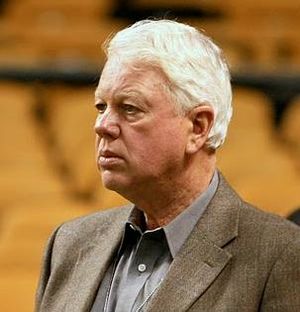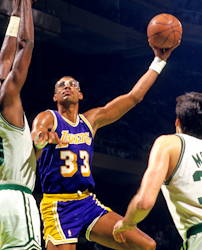Kermit Washington facts for kids

Washington as a sophomore at American University
|
|
| Personal information | |
|---|---|
| Born | September 17, 1951 Washington, D.C., U.S. |
| High school | Coolidge (Washington, D.C.) |
| Listed height | 6 ft 8 in (2.03 m) |
| Listed weight | 230 lb (104 kg) |
| Career information | |
| College | American (1970–1973) |
| NBA Draft | 1973 / Round: 1 / Pick: 5th overall |
| Selected by the Los Angeles Lakers | |
| Pro career | 1973–1982, 1987 |
| Career history | |
| 1973–1977 | Los Angeles Lakers |
| 1977–1978 | Boston Celtics |
| 1978–1979 | San Diego Clippers |
| 1979–1982 | Portland Trail Blazers |
| 1987 | Golden State Warriors |
| Career highlights and awards | |
|
|
| Career NBA statistics | |
| Points | 4,666 (9.2 ppg) |
| Rebounds | 4,232 (8.3 rpg) |
| Assists | 695 (1.4 apg) |
Kermit Alan Washington (born September 17, 1951) is a former professional basketball player from the United States. He is known for his strong defensive play and his ability to grab rebounds. Washington played for ten seasons in the National Basketball Association (NBA). He was also an NBA All-Star once.
Washington was not a top player when he finished high school. He averaged only four points per game in his senior year. However, he improved a lot at American University. He became one of only seven players in NCAA history to average 20 points and 20 rebounds throughout his college career. He was picked by the Los Angeles Lakers as the fifth overall player in the 1973 NBA draft.
Contents
Early Life and School
Kermit Washington was a quiet child. He moved around a lot between relatives when he was young. He felt most comfortable with his great-grandmother, who was strict but loving. When his father remarried, Kermit hoped for a happy family life. But he still felt unwanted by his stepmother. He said he was never hugged as a small child. He only felt close to his younger brother, Chris.
Kermit struggled in school for many years. He had to retake classes in summer school to pass. In high school, he played football to be with a friend. He was scared to walk home alone at night.
As a high school senior, Kermit was 6 feet 4 inches tall but very thin. His biology teacher, Barbara Thomas, gave him positive feedback. This made him try harder in that class. He became good at biology but still struggled in other subjects. When Ms. Thomas became his homeroom teacher, she encouraged him to work hard in all his classes. Kermit quickly improved his grades. He even made the honor roll in his senior year.
His basketball skills in high school were not impressive. He usually came off the bench and scored only four points per game. After high school, his stepmother told him he would have to leave home. He started training hard for three hours a day. He even showed up at a playground game with top players. Tom Young, a coach from American University, saw him play. Young was impressed by Kermit's effort, even though he didn't play perfectly.
College Basketball Journey
During the summer after high school, Kermit grew four inches. He started lifting weights and running stairs to get stronger. College helped Kermit become more outgoing. He often called his college years "the happiest time in my life." He met his future wife, Pat, during his first year. She helped him with his studies, as he was still behind in writing skills.
Kermit practiced basketball a lot. He played in summer leagues and on Urban League teams. In his first year of college basketball, he averaged 18.6 points and 20.5 rebounds. He was still a bit "soft" on the court, which worried professional scouts. Between his second and third years, he started lifting weights with Trey Coleman. Coleman encouraged him to be more aggressive. Kermit was named an academic All-American in his junior year. He averaged 21.0 points and 19.8 rebounds.
After his junior year, he was offered a big contract by the New York Nets of the American Basketball Association (ABA). But he decided to stay at American University for his senior year. He felt he owed it to the school and his coach. He was invited to try out for the 1972 Olympic basketball team but didn't make the cut.
Going into his senior year, Kermit was one of the best players in the country. He led the nation in rebounding again. He was named a second team All-American. He helped American University get into the National Invitation Tournament (NIT). In his last college game, he needed 39 points to average 20 points and 20 rebounds for his entire college career. He scored 40 points, becoming only the seventh player to reach this goal. He graduated with a good GPA and a degree in sociology.
Professional Career Highlights
Los Angeles Lakers (1973–1977)
The Los Angeles Lakers drafted Kermit Washington fifth overall in the 1973 NBA draft. He found it hard to switch from playing center in college to power forward in the NBA. He also had to learn man-to-man defense, which was new to him. He played with basketball legend Jerry West, which made him nervous. He played little in his first three seasons. He also hurt his back but kept it a secret.
Before his fourth season, Kermit felt the Lakers had given up on him. He reached out to Pete Newell, a retired coach who had drafted him. Newell agreed to train Kermit very early in the morning to test his dedication. Kermit showed up every day. Newell was a tough teacher but helped Kermit a lot. He taught Kermit new skills and helped him gain confidence. Newell later became famous for coaching big players.
The Lakers had also gotten Kareem Abdul-Jabbar, a famous player. Kermit's physical style of play worked well with Abdul-Jabbar's game. Kermit played well, averaging 9.7 points and 9.3 rebounds. However, he had knee pain all season. He kept playing with painkillers. He eventually tore a tendon in his knee. Doctors thought his basketball career might be over.
Pete Newell helped Kermit through this tough time. He pushed Kermit through even harder training sessions. Kermit was scared of re-injuring his leg, but Newell told him he had to work harder than ever. Kermit came back the next season and played very well. He was averaging career highs in points and rebounds. He was even featured in Sports Illustrated for his tough playing style.
The Rudy Tomjanovich Incident
On December 9, 1977, during a game between the Lakers and the Houston Rockets, an on-court scuffle happened. During the game, a fight started between players. Kermit Washington was involved. Another player, Rudy Tomjanovich, ran towards the fight. Washington hit Tomjanovich, who was seriously injured and fell to the floor. The arena became very quiet. Tomjanovich missed the rest of the season due to his injuries.
Aftermath of the Incident
The incident was widely reported. Washington was fined $10,000 and suspended for 60 days, missing 26 games. This was the longest suspension for an on-court incident in NBA history at the time. The NBA decided to make stricter rules for fights on the court. Before this, fights were common, and players were not always suspended. After Washington's punch, the league made it clear that throwing a punch would lead to automatic ejection and a suspension. The NBA also added a third referee to games to help prevent such incidents.
Washington felt alone after the incident. However, Pete Newell continued to support him.

On December 27, 1977, Washington was traded to the Boston Celtics. Red Auerbach, the Celtics' general manager, had been a fan of Washington for a long time. Washington became depressed while waiting for his suspension to end. He then started training hard again, running stairs in his hotel.
Washington played well for the Celtics. He played alongside Hall of Fame center Dave Cowens. Celtics fans welcomed him, especially after a positive article was written about him by Bob Ryan of The Boston Globe. Washington even took less money to stay with the Celtics after the season.
San Diego Clippers (1978–1979)
Kermit Washington and Kevin Kunnert, who was involved in the original scuffle, both ended up on the Boston Celtics. Later, the Celtics owner traded franchises with the owner of the Buffalo Braves. Washington and Kunnert were part of the players sent to Buffalo. The Buffalo Braves then moved to San Diego and became the San Diego Clippers.
In November 1978, San Diego played in Houston. The coaches suggested that Washington and Tomjanovich shake hands before the game, but Tomjanovich declined.
Portland Trail Blazers (1979–1982)
After one year in San Diego, Washington was traded again. He, Kunnert, and Randy Smith were sent to the Portland Trail Blazers in exchange for Bill Walton. This was the second time Washington and Kunnert were traded together.
The Portland Trail Blazers really wanted Washington. Their general manager, Stu Inman, was a friend of Pete Newell's. Inman told Washington that this trade would be his last, which was a relief for Kermit and his family. The city of Portland welcomed him warmly.
Washington shared playing time with Maurice Lucas at first. After Lucas was traded, Washington became the full-time starter. He played three seasons in Portland. He was chosen for the 1980 NBA All-Star Game. During that All-Star weekend, his college, American University, retired his jersey number. He was named a team captain the next season. After the incident, many noticed that Washington became less aggressive on the court. He never got into another fight.
Washington started having back and knee pain during the 1980–81 season. The pain became too much during the 1981–82 season. He retired in January 1982 after playing only 20 games that season.
Golden State Warriors (1987)
In 1987, after more than five years away from the NBA, Washington tried to make a comeback with the Golden State Warriors. However, he only played in six games before being released from the team.
NBA Career Statistics
| Legend | |||||
|---|---|---|---|---|---|
| GP | Games played | GS | Games started | MPG | Minutes per game |
| FG% | Field goal percentage | 3P% | 3-point field goal percentage | FT% | Free throw percentage |
| RPG | Rebounds per game | APG | Assists per game | SPG | Steals per game |
| BPG | Blocks per game | PPG | Points per game | Bold | Career high |
Regular season
| Year | Team | GP | GS | MPG | FG% | 3P% | FT% | RPG | APG | SPG | BPG | PPG |
|---|---|---|---|---|---|---|---|---|---|---|---|---|
| 1973–74 | L.A. Lakers | 45 | — | 8.9 | .483 | — | .531 | 3.3 | .4 | .5 | .4 | 3.8 |
| 1974–75 | L.A. Lakers | 55 | — | 17.3 | .420 | — | .590 | 6.4 | 1.2 | .5 | .6 | 4.5 |
| 1975–76 | L.A. Lakers | 36 | — | 13.7 | .433 | — | .682 | 4.6 | .6 | .3 | .7 | 3.4 |
| 1976–77 | L.A. Lakers | 53 | — | 25.3 | .503 | — | .706 | 9.3 | .9 | .8 | 1.0 | 9.7 |
| 1977–78 | L.A. Lakers | 25 | — | 30.0 | .451 | — | .618 | 11.2 | 1.2 | .8 | 1.0 | 11.5 |
| 1977–78 | Boston | 32 | — | 27.1 | .521 | — | .750 | 10.5 | 1.3 | .9 | 1.3 | 11.8 |
| 1978–79 | San Diego | 82 | — | 33.7 | .562 | — | .688 | 9.8 | 1.5 | 1.0 | 1.5 | 11.3 |
| 1979–80 | Portland | 80 | — | 33.2 | .553 | .000 | .642 | 10.5 | 2.1 | .9 | 1.6 | 13.4 |
| 1980–81 | Portland | 73 | — | 29.0 | .569 | .000 | .628 | 9.4 | 2.0 | 1.2 | 1.2 | 11.4 |
| 1981–82 | Portland | 20 | 4 | 20.9 | .487 | — | .585 | 5.9 | 1.5 | .5 | .8 | 5.0 |
| 1987–88 | Golden State | 6 | 1 | 9.3 | .500 | — | 1.000 | 3.2 | .0 | .7 | .7 | 2.7 |
| Career | 507 | 5 | 25.3 | .526 | .000 | .656 | 8.3 | 1.4 | .8 | 1.1 | 9.2 | |
| All-Star | 1 | 0 | 14.0 | .167 | — | .500 | 8.0 | 1.0 | .0 | 1.0 | 4.0 | |
Playoffs
| Year | Team | GP | GS | MPG | FG% | 3P% | FT% | RPG | APG | SPG | BPG | PPG |
|---|---|---|---|---|---|---|---|---|---|---|---|---|
| 1974 | L.A. Lakers | 3 | — | 4.7 | .455 | — | .714 | 3.3 | .3 | .3 | .0 | 5.0 |
| 1980 | Portland | 3 | — | 40.3 | .500 | .000 | .625 | 10.3 | 2.0 | .3 | 1.3 | 10.3 |
| 1981 | Portland | 3 | — | 42.7 | .522 | .000 | 1.000 | 17.3 | 2.3 | 2.7 | .7 | 8.7 |
| Career | 9 | — | 29.2 | .500 | .000 | .706 | 10.3 | 1.6 | 1.1 | .7 | 8.0 | |
Life After Basketball
After retiring from basketball, Kermit Washington managed restaurants. He also started and ran several charitable organizations. He had a restaurant in Vancouver, Washington, with former Trail Blazer Kevin Duckworth. It was called "Le Slam" and closed in 2001.
Washington also worked as a coach at Stanford University. He spent 15 years working at Pete Newell's "Big Man Camp," helping other tall basketball players. In 1995, he founded The 6th Man Foundation, also known as Project Contact Africa. In 1994, he joined doctors and nurses on a mission to help people in a refugee camp in Goma, Zaire (now Congo). He said it was a very sad sight he would never forget.
In the early 2010s, Washington worked as a representative for the National Basketball Players Association in the Washington, D.C. area.
Personal Life
Kermit's older brother, Eric, was a former football player for the St. Louis Cardinals. Eric passed away in 1984.
See also
 In Spanish: Kermit Washington para niños
In Spanish: Kermit Washington para niños
- List of people banned or suspended by the NBA
- List of NCAA Division I men's basketball season rebounding leaders


